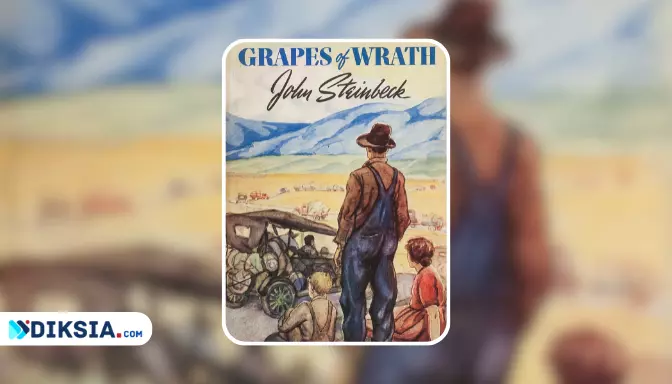Characters and Character Development
The following is a list of the main characters in the novel and their development throughout the story:
- Tom Joad: The protagonist of the novel, a young man who returns to his family after serving four years in prison for killing a man in self-defense. He is strong, brave, loyal, and intelligent, but also impulsive, rebellious, and violent. He loves his family and tries to protect them from harm. He is influenced by Casy’s teachings and becomes more aware of the social and political issues that affect the migrants. He kills a deputy who has killed Casy and becomes a fugitive. He decides to continue Casy’s work of fighting for justice and freedom.
- Ma Joad: The matriarch of the family, a middle-aged woman who is strong, resilient, practical, and compassionate. She holds the family together and takes care of their needs. She is determined to keep her family alive and united. She is supportive of Tom and his decisions. She is proud of her dignity and her spirit.
- Pa Joad: The patriarch of the family, an old man who is weak, passive, insecure, and depressed. He loses his authority and his confidence as he loses his land and his livelihood. He feels guilty and ashamed of his inability to provide for his family. He follows Ma’s lead and tries to help his family as much as he can.
- Jim Casy: A former preacher who has given up preaching because he no longer believes in sin or grace. He is wise, kind, generous, and courageous. He befriends Tom and joins his family on their journey. He questions the traditional religion and develops his own philosophy based on humanism and socialism. He believes that all people are holy and that they have a spirit that connects them to each other and to God. He becomes a labor organizer and leads a strike at a peach orchard. He is killed by a deputy who tries to break up the strike.
- Rose of Sharon: Tom’s younger sister who is pregnant with her first child. She is naive, selfish, vain, and immature. She dreams of having a nice house and a happy family with her husband Connie. She is disappointed and bitter when Connie abandons her and when she loses her baby. She shows a sign of growth and maturity when she breastfeeds a starving man with her milk at the end of the novel.
- Al Joad: Tom’s younger brother who is skilled at driving and fixing cars. He is proud, cocky, irresponsible, and flirtatious. He loves cars more than anything else. He feels burdened by the responsibility of keeping the family car running. He falls in love with Aggie Wainwright, the daughter of another migrant family, and plans to marry her.
- Noah Joad: Tom’s older brother who is quiet, gentle, slow-witted, and deformed. He was born with a twisted spine because Pa tried to deliver him by pulling his head. He feels unwanted and unloved by his family. He leaves his family at the Colorado River and decides to live by himself.
- Uncle John: Pa’s brother who is gloomy, guilt-ridden, and alcoholic. He blames himself for the death of his wife, who died of a burst appendix because he did not take her to a doctor. He tries to atone for his sin by giving gifts or money to strangers. He is loyal to his family and helps them as much as he can.
- Grampa Joad: Pa’s father who is old, stubborn, feisty, and senile. He loves his land and does not want to leave it. He is drugged by his family and taken along with them. He dies on the road and is buried in a shallow grave.
- Granma Joad: Pa’s mother who is old, religious, cranky, and sick. She loves her husband and mourns his death. She becomes delirious and dies on the road just before reaching California.
- Connie Rivers: Rose of Sharon’s husband who is young, ambitious, lazy, and cowardly. He dreams of studying radio engineering and having a good job in California. He abandons his wife and runs away when things get tough.
- Ruthie Joad: Tom’s younger sister who is ten years old. She is childish, spoiled, curious, and playful. She likes to tease her brother Winfield and play with other children. She accidentally reveals Tom’s whereabouts to a boy who insults her, putting him in danger.
- Winfield Joad: Tom’s younger brother who is eight years old. He is childish, innocent, sickly, and scared. He looks up to Tom and Al and wants to be like them. He suffers from stomach ache and fever due to bad food and water.
- Muley Graves: An old neighbor of the Joads who has refused to leave his land. He is stubborn, lonely, proud, and defiant. He lives by himself in the wilderness, hiding from the authorities. He helps Tom and Casy find Tom’s family.
- Ivy and Sairy Wilson: A couple from Kansas whose car has broken down on the road. They are kind, generous, religious, and friendly. They help the Joads by sharing their tent and their food with them. They join the Joads on their journey, but they stay behind when Sairy becomes too sick to travel.
- Floyd Knowles: A young man who lives in a Hooverville with his family. He is smart, brave, honest, and outspoken. He tells the Joads about the reality of California and the labor situation. He stands up to a contractor and a deputy who try to cheat and arrest him, but he escapes with Tom’s help.
- Mr. Thomas: The manager of Weedpatch Camp, a government camp that is run by a committee of migrants. He is fair, helpful, respectful, and sympathetic to the migrants. He welcomes the Joads to the camp and tells them about the rules and the facilities. He warns them about the troublemakers who are sent by the Farmers’ Association to disrupt the camp.
- The Wainwrights: A migrant family from Arkansas who share a boxcar with the Joads at a cotton field. They are friendly, cooperative, hardworking, and religious. They help Rose of Sharon deliver her baby, which turns out to be stillborn. Their daughter Aggie falls in love with Al and plans to marry him.
Theme and Message
The main theme of The Grapes of Wrath is the struggle between the haves and the have-nots in a capitalist society. The novel exposes the injustice and oppression that the migrant workers face at the hands of the wealthy landowners and their agents.
The novel also shows how the migrant workers resist and fight back against their exploiters by organizing themselves into unions and strikes.
Another theme of The Grapes of Wrath is the importance of human dignity and solidarity in times of hardship and suffering. The novel portrays the migrants as people who have lost everything but their dignity and their spirit. The novel also portrays the migrants as people who help each other and share what they have with others who are in need.
The main message of The Grapes of Wrath is that people are more powerful when they are united than when they are divided. The novel suggests that people can overcome their difficulties and achieve their goals if they work together and support each other as a community.
Writing Style
The writing style of The Grapes of Wrath is realistic, naturalistic, and symbolic. The novel uses simple and direct language that reflects the speech and the thoughts of the characters. The novel also uses vivid and detailed descriptions that create a sense of realism and immersion in the setting and the events.
The novel also uses various symbols and metaphors that enhance the meaning and the impact of the story. Some examples of symbols and metaphors are:
- The turtle: It represents the struggle and resilience of nature and life.
- The truck: It represents the family and their journey.
- The dust: It represents the destruction and the despair caused by the drought and the erosion.
- The grapes: They represent the abundance and the waste of California.
- The rain: It represents the hardship and the hopelessness caused by the flood and the mud.
- The breast milk: It represents the compassion and the humanity in the midst of despair and hopelessness.
Pros and Cons
The following is a list of some of the pros and cons of reading The Grapes of Wrath:
Pros:
- It is a classic novel that has influenced many other works of literature and art.
- It is a powerful and poignant novel that depicts the harsh realities of the Great Depression and the Dust Bowl.
- It is a meaningful and relevant novel that explores themes such as human dignity, social justice, family, religion, and the American dream.
- It is a well-written and well-structured novel that uses various techniques such as alternating chapters, symbolism, and dialogue to create an engaging and compelling story.
Cons:
- It is a long and complex novel that requires time and attention to appreciate its depth and richness.
- It is a depressing and tragic novel that deals with serious and mature topics such as poverty, violence, oppression, exploitation, death, hunger, and injustice.
- It is a controversial and provocative novel that challenges some of the dominant values and beliefs of American society.
- It is a biased and propagandistic novel that portrays a clear-cut distinction between the good (the Okies) and the bad (the Californians), without considering other perspectives or nuances.
Comparison to Other Works
The Grapes of Wrath can be compared to other works of literature that deal with similar themes or topics, such as:
- Of Mice and Men by John Steinbeck: Another novel by Steinbeck that depicts the lives of migrant workers in California during the Great Depression. It focuses on the friendship between two men, George and Lennie, who dream of owning their own farm. It is shorter and simpler than The Grapes of Wrath, but also more tragic and emotional.
- To Kill a Mockingbird by Harper Lee: A novel that portrays the racial injustice and social inequality in Alabama during the 1930s. It focuses on the childhood and education of Scout Finch, who learns about courage and compassion from her father Atticus Finch, a lawyer who defends a black man accused of raping a white woman. It is more optimistic and humorous than The Grapes of Wrath, but also more moralistic and sentimental.
- The Jungle by Upton Sinclair: A novel that exposes the corruption and exploitation in the meatpacking industry in Chicago during the early 20th century. It focuses on the immigration and assimilation of Jurgis Rudkus, a Lithuanian who works in a slaughterhouse. It is more political and radical than The Grapes of Wrath, but also more sensationalistic and melodramatic.
Where To Read Book
The Grapes of Wrath can be read in various formats and platforms, such as:
- Print: You can buy or borrow a physical copy of the book from a bookstore or a library. You can enjoy reading it on paper, with its original layout and design.
- E-book: You can download or stream a digital copy of the book from an online store or a service. You can enjoy reading it on an electronic device, with its adjustable font size and brightness.
- Audiobook: You can listen to an audio recording of the book from an online store or a service. You can enjoy listening to it on an audio device, with its professional narration and sound effects.
Conclusion
The Grapes of Wrath is a classic novel by John Steinbeck that tells the story of the Joad family, a poor farming family from Oklahoma who migrate to California during the Great Depression and the Dust Bowl. The novel explores themes such as human dignity, social justice, family, religion, and the American dream.
The novel is realistic, naturalistic, and symbolic in its writing style. The novel has pros such as being powerful, poignant, meaningful, and well-written; and cons such as being long, complex, depressing, tragic, controversial, provocative, biased, and propagandistic.
The novel can be compared to other works such as Of Mice and Men, To Kill a Mockingbird, and The Jungle. The novel can be read in various formats and platforms such as print, e-book, and audiobook.
I hope you enjoyed this article and learned something new about The Grapes of Wrath. If you are interested in reading the novel, you can find it in your local bookstore or library, or online.
If you have read the novel, I would love to hear your thoughts and opinions about it. Please leave a comment below and share your views with me and other readers. Thank you for reading!






